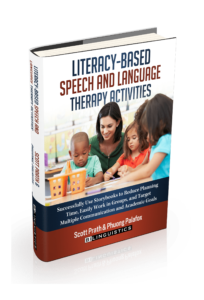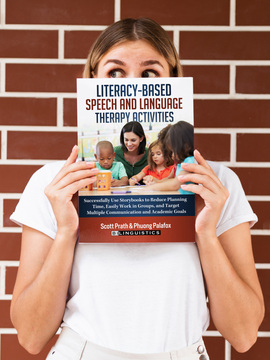I am a book hoarder. It started out innocently enough. I would purchase a book, relish in each page and place the prized possession on a shelf. The spines of the books, with the titles perfectly exhibited, served as my trophy display. Before long, I found myself collecting books for my students. Curriculum-based speech-language therapy was the goal, literacy-based intervention was my medium, and Sendak, Carle and Potter were my inspirations. Now, I find myself sneakily hiding my own offsprings’ books on my shelves. I have a problem, and I cannot lie.
Early in my career, I used books because they was engaging and fun. Now, I understand the impact they make. Literacy-based intervention makes a difference for our students. Remember, the goal of speech and language therapy is to support our students in the classroom, right? What better way to address these functional skills than to use books, books and more books.
Here are 5 steps to reduce therapy planning and increase alignment to the curriculum:
1. Align to the curriculum.
The Individuals with Disabilities Education Improvement Act of 2004 (IDEA 2004) is a law mandating equality and accountability for children with disabilities. It states that we need to align what we are doing to our students’ general education core standards. The best way to address these core standards is to use literacy based intervention. It is a natural and easy way to address vocabulary, story components and higher-level thinking activities.
Here are examples of goals set forth by in the Texas Essential Knowledge and Skills in the area of English Language Arts and Reading:
- Students analyze, make inferences and draw conclusions about theme and genre in different cultural, historical, and contemporary contexts and provide evidence from the text to support their understanding.
- Students understand new vocabulary and use it when reading and writing.
- Students use elements of the writing process to compose text. Students are expected to develop drafts by sequencing ideas through writing sentences.
2. Meet with your students’ teachers.
If you cannot meet with them, email and videoconferencing work just as well. In this 5-7 minute meeting, ask your teachers what book(s) they are going to be reading in the next few weeks. Also ask about specific vocabulary. Then plan for literacy based intervention. Here is a sample email response I got from a 2nd grade teacher:
3. Use Common Vocabulary.
Sometimes, it is not necessarily what we do, it’s how we do it. There are many effective programs out there. Instead of spending our time on the nitty-gritty of a program, give more time and thought to how we can make our strategies more meaningful for our students. For example, by using the same vocabulary between teachers, speech-language pathologists and special education teachers, we are making information more salient for our students. I have used brain-based strategies (effective teaching strategies that engage how the brain works in the context of learning) through the use of hip-hop to teach story grammar components. Once students know the rhymes and the beat, I share this rap with classroom teachers. Now, instead of the students learning the story grammar components in a pull-out speech session, the teachers are using the same verbiage in the classroom – everyday.
4. Do some inclusive therapy – show ‘em what you got!
As SLPs, we are the language experts. Teachers are the content experts. Through collaboration, the synergistic educational possibilities are endless. In the past, I have gone into the classroom to teach an entire class. Can all students benefit from language strategies? Yes! Will your student potentially gain confidence from having you teach his peers? Absolutely. Will the teacher learn language scaffolding strategies from you? Yes, yes and yes! Will you learn more about your student’s performance in the classroom? Naturally. I have taught the following skills in a general education classroom: story grammar components, methods for describing text, organizing for letter writing, social skills, methods for text visualization and vocabulary.
5. Save materials for re-use.
Once you have completed steps 1-4, save the materials you used in your literacy based intervention for the specific book in one common place. As SLPs, each year should get easier. Our effort should be cumulative. By organizing your materials each year and making each book purposeful, you are saving time for future groups.
Resources to get you started quickly:
Some books to get you started that work well in speech therapy:
El gallo que fue a la boda de su tío
Un sillon para mi mama
There Was An Old Lady Who Swallowed a Bell






